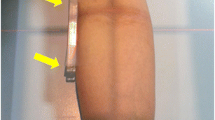Abstract
The aim of this study was to perform biometry of the proximal extremity of the radius and to characterize the shape of the radial head. Knowledge of the size and shape of the radial head is necessary for the creation of a radial head prosthesis that is anatomically and biomechanically correct. Twenty-seven measurements, focused on the proximal extremity, were done on 96 radii. The shape of the radial head was determined by the difference between the maximum diameter and the minimum diameter. We considered the shape to be circular when the difference was less than 1 mm, and elliptical when the difference was greater than 1 mm. The shape of the radial head was compared with the neck/diaphysis angle. Fifty-seven percent of radial heads were elliptical and 43% were circular. When the head was elliptical the maximum diameter was 22 mm ±2.9 and the minimum diameter was 20 mm ±2.8 (P<0.001). When the head was circular the maximum diameter was 21.2 mm ±2.4 and the minimum diameter was 20.4 mm ±2.4 (P<0.14). The angle between the neck and the diaphysis varied with regard to the shape of the radial head. It was 166.75° ±3 for the circular heads and 168.62° ±3.2 for the elliptical heads (P<0.01). The biomechanics of the circular shape and the elliptical shape are different, involving an adaptation of the angle between the neck and the radial diaphysis. This difference must be taken in consideration in the design of a radial head prosthesis.
The French version of this article is available in the form of electronic supplementary material and can be obtained by using the Springer Link server located at http://dx.doi.org/10.1007/s00276-002-0059-9.
Résumé.
Cette étude avait pour but de réaliser la biométrie de l'extrémité proximale du radius et de caractériser la forme de la tête radiale. La connaissance de la taille et de la forme de la tête radiale est indispensable pour la conception d'une prothèse de tête radiale adaptée sur les plans biomécanique et anatomique. Vingt-sept mesures, centrées sur l'extrémité proximale du radius, ont été réalisées sur 96 radius. La forme de la tête radiale était déterminée par la différence entre le diamètre maximum et le diamètre minimum. Nous l'avons considérée circulaire lorsque la différence était inférieure à 1 mm, et elliptique lorsque la différence était supérieure à 1 mm. La forme de la tête radiale était comparée à l'angle col/diaphyse. On retrouvait 57,3% têtes radiales elliptiques et 42,7% têtes radiales circulaires. Lorsque la tête était elliptique le diamètre maximum était de 22 mm ±2,9 et le diamètre minimum était de 20 mm ±2,8 (P<0,001). Lorsque la tête radiale était circulaire le diamètre maximum était de 21,2 mm ±2,4 et le diamètre minimum de 20,4 mm ±2,4 (P<0,14). L'angle entre le col et la diaphyse variait en fonction de la forme de la tête radiale. Il était de 166,75° ±3 pour une tête circulaire et de 168,62° ±3,2 pour une tête elliptique (P<0,01). Le fonctionnement biomécanique entre la forme circulaire et la forme elliptique est différent, ce qui implique une adaptation de l'angle entre le col et la diaphyse radiale. Cette différence doit être prise en compte dans la conception de prothèse de tête radiale.
Similar content being viewed by others
Author information
Authors and Affiliations
Additional information
Electronic Publication
Rights and permissions
About this article
Cite this article
Captier, .G., Canovas, .F., Mercier, .N. et al. Biometry of the radial head: biomechanical implications in pronation and supination. Surg Radiol Anat 24, 295–301 (2002). https://doi.org/10.1007/s00276-002-0059-9
Received:
Accepted:
Issue Date:
DOI: https://doi.org/10.1007/s00276-002-0059-9




